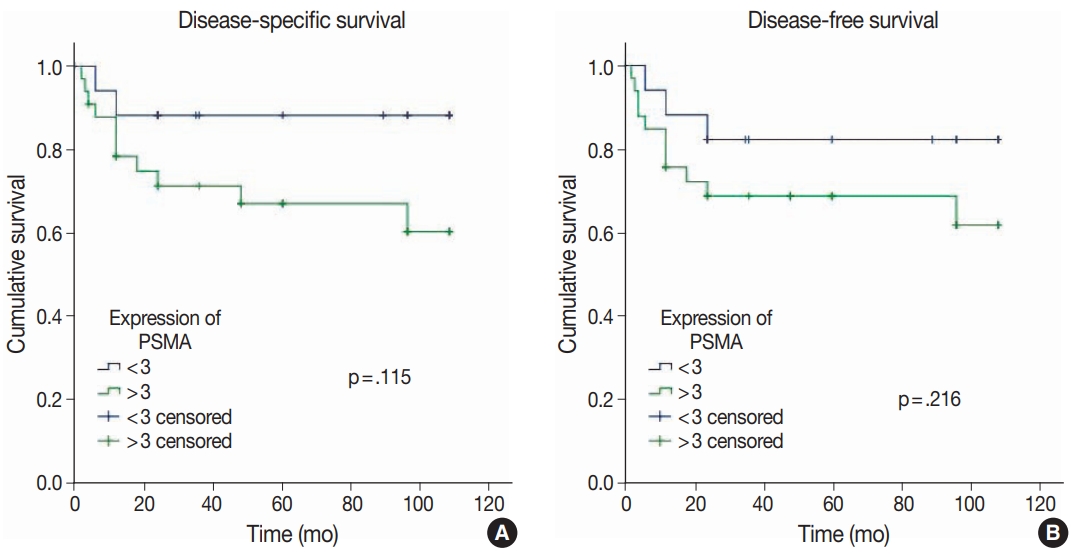Expression of prostate-specific membrane antigen in the neovasculature of primary tumors and lymph node metastasis of laryngeal squamous cell carcinomas
Article information
Abstract
Background
Prostate-specific membrane antigen (PSMA) expression is encountered in tumor-associated neovascularization.
Methods
PSMA-antibody was applied to the paraffin blocks of 51 patients who were diagnosed with squamous cell carcinoma of the larynx and underwent laryngectomy and one who underwent lymph node dissection. The percentage of vascular expression in tumoral and extratumoral stroma and lymph nodes and intensity score in tumoral epithelium were evaluated and divided into groups according to the level of PSMA expression. Final PSMA expression was determined by multiplying intensity and percentage scores.
Results
The mean age was 61±10 years. Patients with perineural invasion, cartilage invasion, and local invasion exhibited higher PSMA expression scores. Age, tumor differentiation, tumor diameter, perineural invasion, tumor localization, capsular invasion, depth of invasion, surgical margin status, local invasion, nodal metastasis, TNM classification, and stage were similar in high and low PSMA expression groups. There was no PSMA expression in extratumoral vascular stroma. Significantly higher PSMA expression was observed in the vascular endothelium of metastatic lymph nodes compared with reactive lymph nodes. Patients with advanced-stage disease exhibited higher PSMA vascular expression scores compared to those with earlier stages (p<.001). PSMA expression was not correlated with overall survival, disease-specific survival, or disease-free survival (p>.05).
Conclusions
Our study suggests that higher PSMA expression is associated with cartilage invasion, local invasion, and advanced-stage of disease. PSMA expression can be utilized for detection of lymph node metastasis and has some predictive role in cases of neck metastasis.
The prevalence and incidence of laryngeal cancers, mostly constituted of squamous cell carcinoma (SCC), have increased by 23.8% and 12%, respectively, in the last 30 years, and the survival of patients with advanced-stage disease remains low [1]. Despite developments in diagnostic and therapeutic techniques, novel and more effective treatment strategies are needed to increase survival, particularly for patients with advanced-stage disease. The microvascular intensity of tumors is positively correlated with T/N category, T/N relapse, and tumor radiosensitivity. Treatment modalities targeting the antigens of active vascular endothelial cells can be beneficial when combined with conventional chemotherapies [2]. Angiogenesis is the formation of new vessels from existing vessels as a response to changes in the circulatory system such as hypoxia. The term neoangiogenesis is also used to define the pathologic angiogenesis of different vessels in the presence of a tumor and other diseases [3]. The relationship between angiogenesis and prognosis in SCC of the larynx (SCCL) was determined in the 1990s [4].
Tumor vessels can be targeted for treatment and prevention of recurrence to protect normal vascular structures from deterioration due to continuous growth and abnormality of tumor vessels. For instance, target-oriented anti–epidermal growth factor receptor treatment has been approved by the United States Food and Drug Administration for treatment of head-neck SCCs [5].
Prostate-specific membrane antigen (PSMA), also known as glutamate carboxypeptidase, is a type 2 transmembrane glycoprotein with a molecular weight of 100 kDa including both intracellular and extracellular domains that have been demonstrated to be expressed in prostate cancers and commonly researched in the field of target-oriented treatment [6,7]. There are several complete, ongoing, and interrupted studies on numerous different clones of PSMA (e.g., ADC 2301, ADC BrUOG 263, ADC 1301) within the content of phase 1 and phase 2 trials conducted to investigate the availability of PSMA for use in treatment and imaging procedures. PSMA expression has been confirmed by RNase protection assay, western blot analysis, and immunohistochemical methods [8].
PSMA expression was demonstrated in the neovascularized foci of solid organ tumors (e.g., breast, lung, kidney, brain, thyroid, hepatocellular carcinoma, urothelial carcinoma). PSMA is more commonly encountered in tumor-associated new blood vessels and is not detected in the normal vascular endothelium in solid tumors [9]. The specificity of PSMA for tumor-associated endothelium suggests it as a potential target for treatment of malignancies.
We aimed to evaluate PSMA expression in the vascular endothelium of primary tumors and lymph nodes in patients with SCCL.
MATERIALS AND METHODS
Patients and tissue samples
This study included 51 patients with SCCL who underwent total or partial laryngectomy and neck dissection between January 2010 and January 2020. The hematoxylin and eosin (H&E)-stained sections obtained from all the formalin-fixed paraffin blocks of the patients were re-examined, and appropriate blocks were selected from 17 patients with lymph node metastasis and 34 patients without lymph node metastasis. Neck dissection was performed in patients with clinical and/or radiologic findings suspicious for positive lymph nodes in the neck.
All cases were histopathologically confirmed according to the 4th edition of the World Health Organization (WHO) classification of head and neck tumors [10]. The Protocol for the Examination of Specimens from Patients with Cancers of the Larynx 2017 of the College of American Pathologists was used to identify histopathologic subtype, tumor location, tumor size, tumor differentiation, tumor spread, surgical margins, lymphovascular invasion, perineural invasion, and lymphatic spread for SCCL [11]. Tumor stage was determined retrospectively for all patients according to the TNM Classification System of the American Joint Committee on Cancer [11]. Data such as clinical information, age, sex, presence of metastasis, and survival data including diseasefree survival (DFS), overall survival (OS), disease-specific survival (DSS), and recurrence were obtained from the hospital database.
Immunohistochemistry
PSMA antibodies were applied to the blocks that represented tumors, and blocks were selected from metastatic lymph nodes or tumor-negative lymph nodes in the absence of metastatic lymph nodes using an immunohistochemical method in the H&E-stained sections (Fig. 1A). PSMA antibodies (clone 3E6, isotype: IgG1, kappa, DAKO flex ready-to-use monoclonal mouse antibody (Carpinteria, CA, USA) provided in liquid form in a buffer containing stabilizing protein and 0.015 mol/L sodium azide) were prepared according to the manufacturer’s instructions as expressed in the datasheet. The tissue samples were processed together with prostate tissue samples as an antibody-positive control and a negative control in an automated immunohistochemistry device.
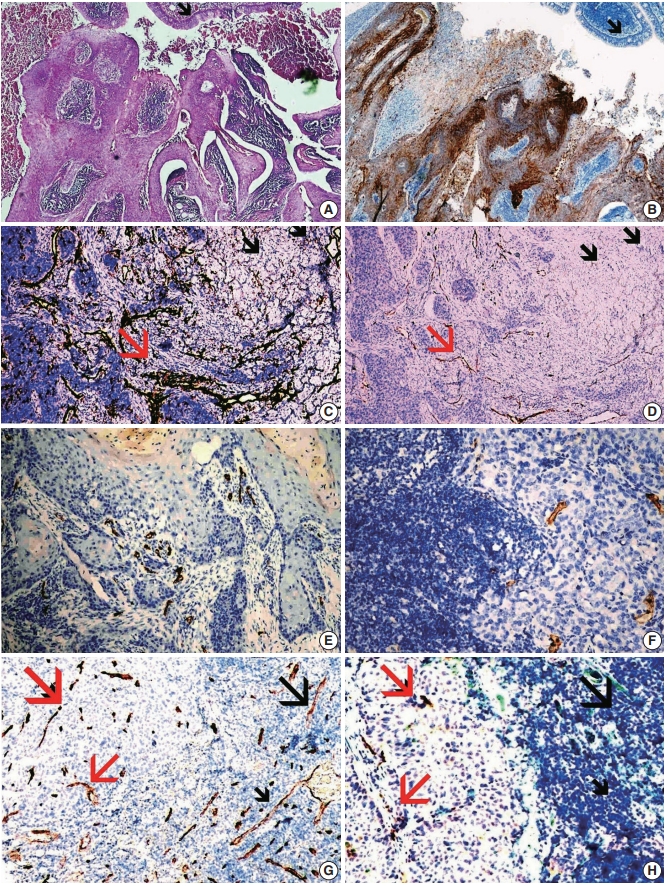
Hematoxylin and eosin (H&E) and immunohistochemistry (IHC) staining of tumoral and nontummoral tissues. (A) Primary squamous cell carcinoma and respiratory epithelium (arrow) in the neighborhood of the tumor (H&E). (B) High prostate-specific membrane antigen (PSMA) expression score in the epithelium of the primary squamous cell carcinoma, no PSMA expression in the normal respiratory epithelium (arrow). (C) CD34 expression in the vessels of the tumoral stroma (red arrow) and non-tumoral stroma (black arrow). (D) High PSMA expression score in the vessels of the tumoral stroma (red arrow) and no expression of PSMA in the vessels of the normal tissue (black arrows). (E) PSMA expression in the vessels of the primary tumor (F) and expression in the vessels of the metastatic lymph node. (G) CD31 expression in the stromal vessels of the metastatic focus (red arrows) and non-metastatic focus (black arrow) of the same lymph node. (H) PSMA expression in the stromal vessels of the metastatic focus (red arrows) and no expression in the vessels of the non-metastatic focus (black arrow) of the same lymph node.
Evaluation of immunohistochemical staining
Immunohistochemically stained slides were evaluated by two pathologists who were experienced in head and neck pathology, with each being blinded to the cases. PSMA immunohistochemically stained slides were examined under a light microscope and accepted as having positive cytoplasmic staining and/or positive cytoplasmic membrane staining.
The percentage of vascular endothelial cells that stained positive for PSMA was stratified as: 0, 0%–5%; 1, 6%–25%; 2, 26%–50%; and 3, >50%. The intensity score was stratified as: 1, weak; 2, moderate; and 3, strong. PSMA expression was scored according to the intensity of the tumor epithelium as: 1, none-weak; 2, moderate; and 3, strong. Final PSMA expression was determined by multiplying intensity and percentage scores. The cases were grouped according to stage and lymph node metastasis. The groups were compared by PSMA expression scores [12,13].
Statistical analysis
The normality of continuous data distribution was tested using the Kolmogorov-Smirnov test or the Shapiro-Wilk test. Continuous data were compared using the independent sample t test or the Mann-Whitney U test. Categorical data were compared using Pearson’s chi-square test. Fisher’s exact test was used when expected value problems occurred. Kaplan-Meier survival analysis was conducted to predict survival estimates according to PSMA expression score. Receiver operator curve (ROC) analysis was performed to determine the cut off value for PSMA expression in assessing the event of death during follow-up. Patients were classified into two groups according to cut off value as high and low expression of PSMA. A p-value<.05 was regarded as statistically significant. The SPSS ver. 21 software package (IBM Corp., Armonk, NY, USA) was used for statistical analysis.
RESULTS
All but one patient were male (98%). The mean age was 61±10 years. Of the primary tumors, 37.3%, 43.1%, and 19.6% were well-differentiated, moderately differentiated, and poorly differentiated, respectively. Fifty (29.4%), 12 (23.5%), one (2%), six (11.8%), eight (15.7%), and nine (17.6%) tumors were located in the supraglottic, glottic, infraglottic, supraglottic+glottic, glottic+infraglottic, and transglottic regions, respectively. Table 1 shows the demographic data of the patients. Age was similar between the high and low vascular expression groups. Tumor differentiation was similar between the high and low vascular expression score groups. Tumor diameter and perineural invasion was similar between the groups. Supraglottic localization was more frequent in the low vascular score group compared to the high group. Transglottic localization was more frequent in the high vascular score group. Capsular invasion, depth of invasion, lymphovascular invasion, surgical margin positivity, and local spread nodal metastasis were similar between the groups. The presence of T4 tumors and stage 4 disease was more frequent in the high vascular PSMA expression group. Comparison of the high and low vascular PSMA expression groups is shown in Table 2.
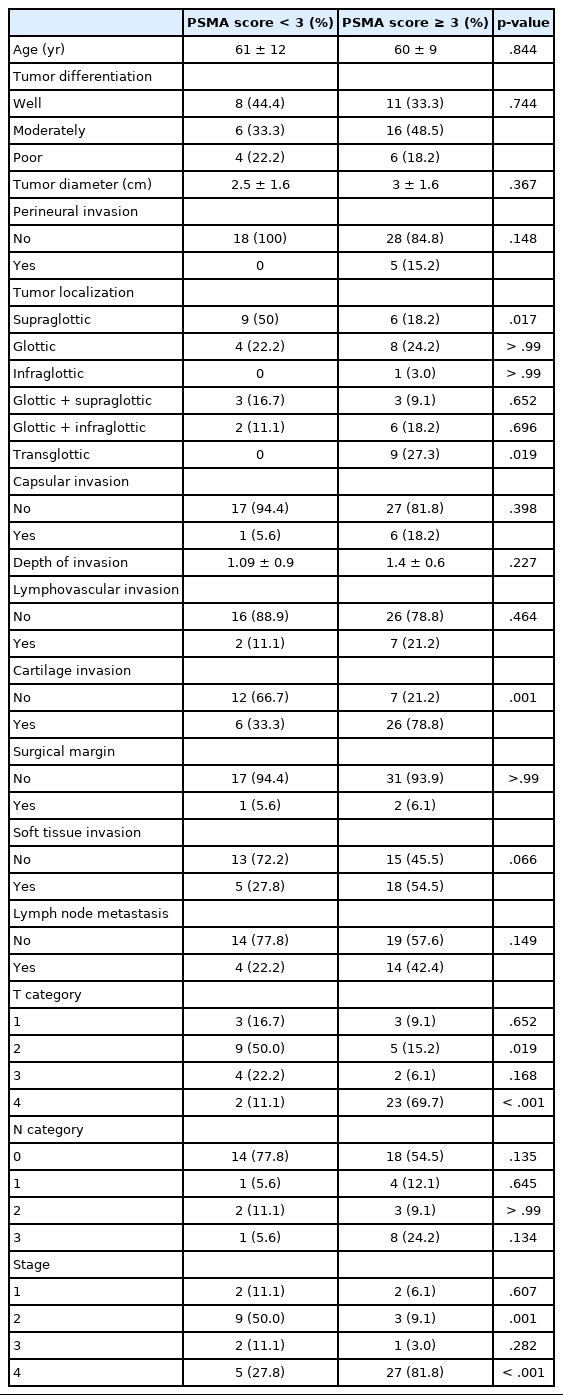
The correlative evaluation between clinical findings, histopathological findings, and clinical stages of the cases and PSMA expression scores in the intratumoral vessels
We evaluated the expression of PSMA in tumoral epithelium and divided the patients according to expression levels. Age, tumor differentiation, tumor diameter, perineural invasion, tumor localization, capsular invasion, depth of invasion, surgical margin status, local invasion, nodal metastasis, TNM classification, and stage were similar in the high and low intratumoral PSMA expression groups. PSMA expression in tumoral epithelium is shown in Table 3.
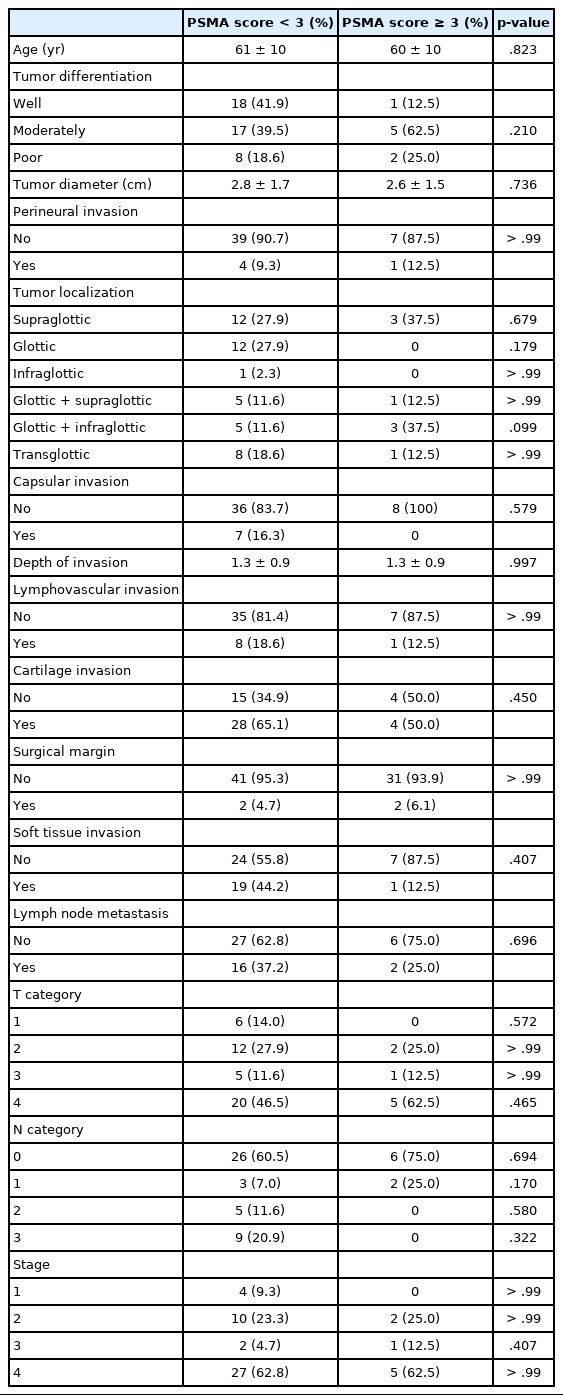
The correlative evaluation between clinical findings, histopathological findings, and clinical stages of the cases and PSMA expression scores in the tumoral epithelium
ROC analysis revealed that PSMA was a significant marker of death. A PSMA cut off value of 3 exhibited the highest sensitivity and specificity (area under the curve, 0.705; sensitivity, 81%; specificity, 51%). Patients were divided into two groups according to PSMA expression as high (≥3) and low (<3).
PSMA expression in the vascular epithelium of lymphatic metastasis was significantly higher compared with that in patients with tumor-negative lymph nodes (p<.001) (Table 4). Most patients with lymphatic metastasis exhibited higher primary tumoral PSMA expression. However, no significant difference was found between patients with and without lymph node metastasis in terms of PSMA expression.

The comparison between percentage scores of prostate-specific membrane antigen expression in metastatic and reactive lymph nodes
A higher vascular expression score of PSMA was observed in pT4 tumors. Similarly, higher vascular PSMA scores were observed in stage 4 tumors. No significant correlation with pN was detected for PSMA score.
PSMA expression in the epithelium of the primary SCCL is shown in Fig. 1B. Staining with CD34 demonstrated the difference between normal and tumoral vessels as shown in Fig. 1C. PSMA expression in the vessels of the tumoral stroma are shown on Fig. 1D. PSMA expression in the vessels of a primary tumor (Fig. 1E) and PSMA expression in the vessel cells of the metastatic focus are shown in Fig. 1F. CD31 expression in stromal vessels of the metastatic focus and non-metastatic focus of the same lymph node are shown in Fig. 1G, and PSMA expression in the stromal vessels of the metastatic focus are shown in Fig. 1H. The intratumoral vascular PSMA percentage scores are shown in Fig. 2A–C. Intratumoral PSMA intensity scores are shown in Fig. 2D–F.
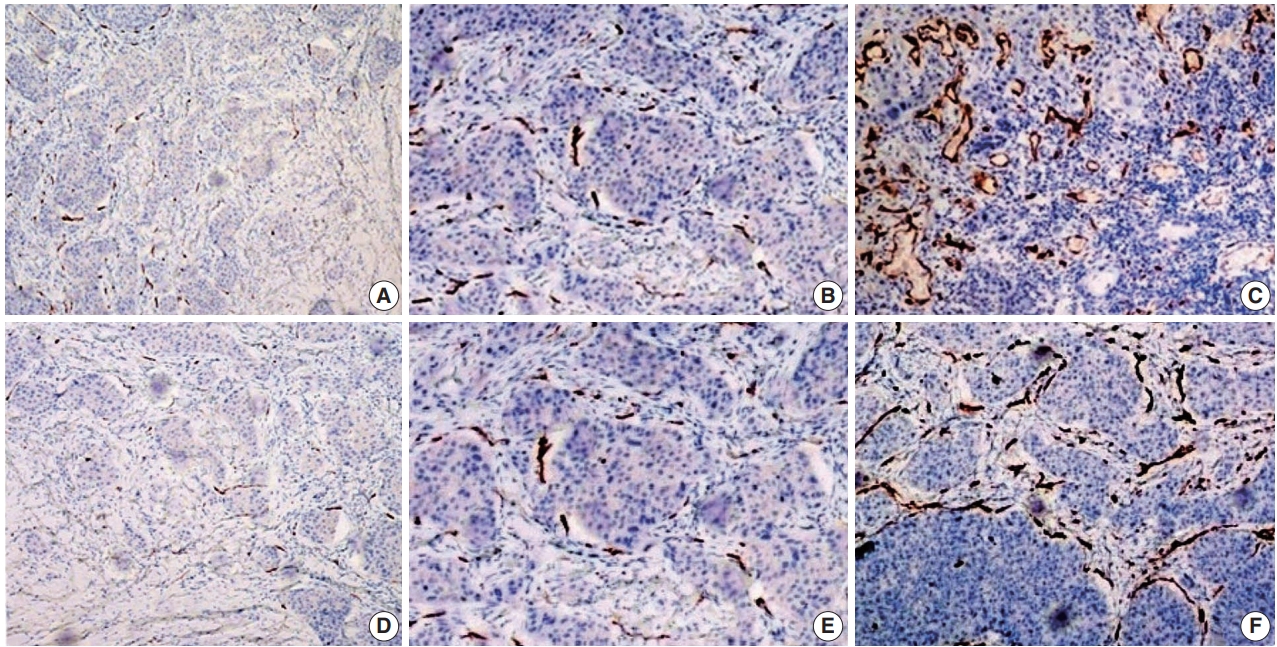
PSMA expression scores in tumoral and nontumoral tissues. (A) Prostate-specific membrane antigen (PSMA) percentage score of 1 in the vessels of the tumoral stroma. (B) PSMA percentage score of 2 in the vessels of the tumoral stroma. (C) PSMA percentage score of 3 in the vessels of the tumoral stroma. (D) PSMA intensity score of 1 in the vessels of the tumoral stroma. (E) PSMA intensity score of 2 in the vessels of the tumoral stroma. (F) PSMA intensity score of 3 in the vessels of the tumoral stroma.
No distant organ metastasis was detected in any of the cases. Vascular PSMA expression in metastatic lymph nodes and primary tumors was similar (p=.383). No significant correlation was detected between PSMA expression scores in the tumoral vessels and OS, DSS, and DFS (p>.05) (Figs. 3, 4).
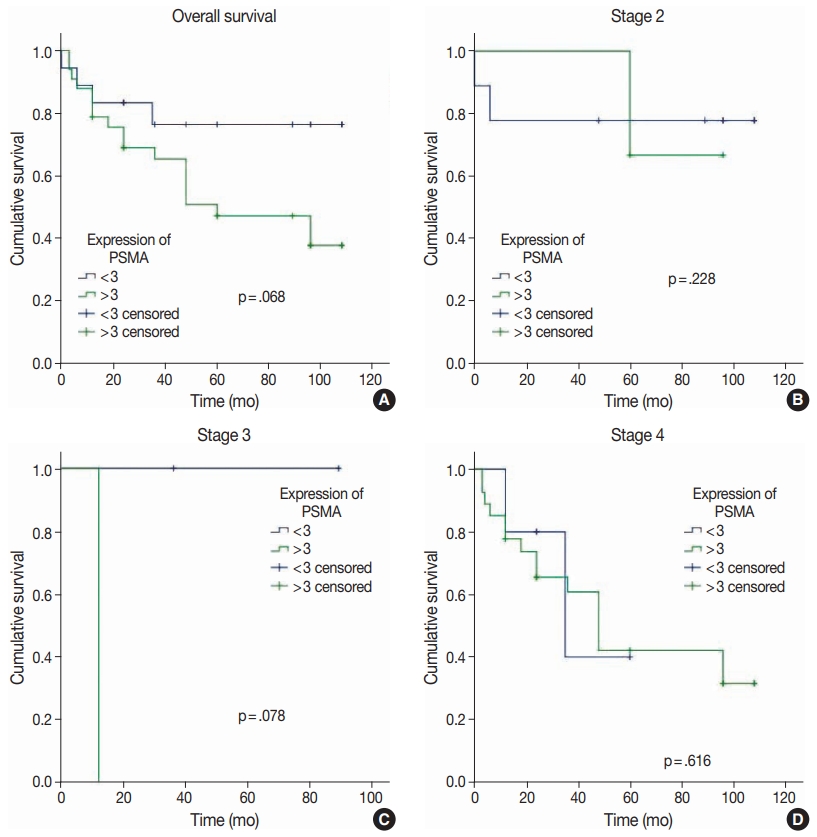
Overall survival analysis in patients with high and low prostate-specific membrane antigen (PSMA) expression scores according to disease stage. (A) Comparison of overall survival in stage 1 patients according to PSMA expression. (B) Comparison of overall survival in stage 2 patients according to PSMA expression. (C) Comparison of overall survival in stage 3 patients according to PSMA expression. (D) Comparison of overall survival in stage 4 patients according to PSMA expression.
DISCUSSION
We separately analyzed the expression of PSMA in the stroma of primary tumors, metastatic lymph nodes, non-metastatic lymph nodes, vascular endothelium in the stroma of extratumoral foci, and tumoral epithelium of SCCLs. Many studies have evaluated PSMA expression in intratumoral neovascularized foci [9,14-16]. However, no study has reported PSMA expression in SCCL, and we also compared PSMA expression in metastatic lymph nodes and vascular endothelium in the primary tumoral stroma.
Abnormal stromal cells and neovascularized dysfunctional angiogenic vessels continuously contribute to the microenvironment of the tumor. Certain cancer types that metastasize through hematogenous and lymphatic patterns were reported to be affected by tumor neovascularization [17]. The metastasis, growth, and progression of solid tumors require angiogenesis. In addition to tumoral nutrition, angiogenesis plays an important role in obtaining treatment responsiveness from chemoradiotherapy depending on the quality of the intratumoral vessels. Therefore, a balance between pro- and anti-angiogenic factors should be established [18]. Our study included patients with SCCL who underwent cervical lymph node dissection, and metastatic lymph nodes were detected in 17 of 51 patients, about one-third of the cases.
Angiogenesis is crucial in tumor metastasis [19]. In this respect, it is proposed that antiangiogenic treatment will be of importance in treatment of tumor metastases in the future [20]. In our study, none of the cases exhibited diffuse strong staining with PSMA in the extratumoral normal vascular structures. New investigations of PSMA-ligated treatment strategies could be attempted in cases of advanced tumors when surgical treatment options are impossible.
A proangiogenic microenvironment is considered to increase lymphatic metastatic risk. Even though the 5-year survival rate is commonly high in patients with low T-category and without metastatic lymph nodes, detection of high vascular endothelial growth factor (VEGF) expression has been interpreted to be high risk for poor prognosis and recurrence. Therefore, it is anticipated that these patient groups will benefit from targeted treatment modalities [20]. In our study, the percentage and intensity scores of PSMA expression in intratumoral vessels were significantly high in cases with advanced T-category. PSMA expression scores were 0 and 1 in vessels with a non-metastatic focus in lymph nodes that maintained normal lymph node morphology, whereas PSMA expression scores were significantly higher at scores 2 and 3 in neovascularized vessels in metastatic foci. Therefore, PSMA seems to be a new key factor in the specific target-oriented treatment of both primary tumors and lymph node metastatic foci, but further studies are necessary to confirm this hypothesis.
A significant level of VEGF expression was encountered, whereas no expression was detected in intratumoral stromal cells in another study that investigated the relationship of VEGF expression with angiogenesis in SCCL. Those authors concluded that progression of SCC was compliant with VEGF expression [21]. By contrast, in another study, no correlation was observed between prognosis and angiogenesis in SCCL [22]. In our study, PSMA expression in tumoral vascular endothelium was associated with poor clinical parameters including cartilage invasion, local invasion, and advanced-stage disease.
PSMA positivity was observed in 151 of 779 tumors in a study that evaluated PSMA expression in bone and soft tissue tumors in tumor-associated vascular structures. A higher concentration of PSMA expression was observed in high-grade tumors compared to intermediate and low-grade tumors. However, it was reported that false-negative expression might be present because a tissue microarray system was used in the study [23]. Similarly, in another study, it was reported that neovascular PSMA expression was significantly higher in malignant tumors of the thyroid gland compared to benign lesions, and that expression rates increased in poorly differentiated and undifferentiated tumors [24]. In our study, we identified no correlation between PSMA expression score and differentiation of SCCL.
Our study showed that the intensity and percentage scores of PSMA expression in the vascular endothelium of primary tumor stroma were significantly higher in cases with cartilage and local tumor invasion. It was additionally noted that PSMA expression scores were significantly high with scores 2 and 3 in the intratumoral vessels of pT4 tumors. However, we found no correlation between the expression scores of PSMA in intratumoral vessels and OS, DSS, and DFS.
Specific target-oriented molecular therapies present a crucial necessity for treatment of tumor-associated vessels [25]. Vascular PSMA expression was determined to be correlated with several cancer types with respect to clinicopathologic and prognostic features. No PSMA expression was identified in 24 of 96 patients with SCC of the oral cavity, whereas PSMA expression was observed in less and more than 50% of tumor-associated vessels in 24 and 24 cases, respectively. Therefore, high vascular expression of PSMA was correlated with poor prognosis in oral SCC [13]. Vascular PSMA expression was correlated with the Ki67 proliferation index, which has prognostic importance in breast cancer [12]. PSMA expression in the vascular endothelium was determined to be significantly correlated with TNM, the Ki67 proliferation index, tumor differentiation, and positivity of lymph node metastasis in 103 patients with hepatocellular carcinoma [25]. Similarly, PSMA expression has been evaluated in gynecologic cancers and was encountered in the neovascular foci of specific and high-grade tumors in endometrial, ovarian, and cervical SCC, while vulval SCC exhibited no such phenomenon [13].
PSMA expression was identified in tumor-associated vessels in 46% (31/68) of patients with breast cancer and metastasis [16]. The relationship of PSMA expression with distant organ metastasis could not be analyzed in our study because no distant organ metastasis was present in any of our patients.
Early diagnosis and treatment of tumors are important to avoid surgery with high comorbidity for patients such as laryngectomy. Researchers have found that the use of nitric oxide synthase blockers is a promising tool in the scope of antiangiogenic therapy in SCCL [26]. Similarly, PSMA can be considered a target in early-stage tumors because it exhibits specific expression in the vessels of the neoplastic foci.
The limitation of this study was that our study was retrospective, observational, and included patients who underwent neck dissection for SCCL, limiting the number of cases. Heterogeneity of sex was another limitation, which was caused by the male dominance of larynx tumors. In our study, there was only one female patient. Therefore, the relationship between expression of PSMA and sex could not be evaluated. Our study included patients that were followed for a period between 12 and 120 months. The survival analysis revealed no difference between the groups in terms of PSMA expression. However, this might be due to the limited follow-up of the patients that were included in the study in recent years.
Both proangiogenetic and antiangiogenetic drugs will be introduced in the near future as alternative treatment options to suppress tumor blood circulation and halt tumor progression [24]. Numerous preclinical animal studies and case reports of patients with cancer have supported the validity of antiangiogenic therapy [27-29]. The rapidly increasing amount of information on tumor angiogenesis, current information on the biologic behavior of cancer, and implementation of imaging studies to display clinical interventions and tumoral vascularity support antiangiogenic therapy as a new treatment method by facilitating its development. Novel developments will be achieved using innovative molecular analysis technologies to display neovascularization using imaging techniques such as positron emission tomography, computed tomography and magnetic resonance imaging to confirm tumor mass. We anticipate that PSMA will be used as a target of alternative or adjuvant treatment options to surgical procedures for treatment of cancer and metastases. However, this anticipation will only be realized with further prospective studies.
PSMA expression in tumoral vascular endothelium was associated with poor clinical parameters including cartilage invasion, local invasion, and advanced stage. PSMA expression can be used for detection of lymph node metastasis. PSMA seems to be a mediator for novel diagnostic and treatment options in the targeted therapy of advanced-stage laryngeal tumors and their metastases.
Notes
Ethics Statement
The study protocol was approved by the institutional review board (258-11.09.2020). The study was designed as a retrospective study; therefore, informed consent was not obtained from the patients.
Availability of Data and Material
The datasets generated or analyzed during the study are available from the corresponding author on reasonable request.
Code Availability
Not applicable.
Author Contributions
Conceptualization: GE, HY, MES. Data curation: YÇK, MD, GE. Formal analysis: HY, MES. Funding acquisition: GE. Investigation and evaluation of slides: GE, MD. Methodology: GE, HY, MES, YÇK, MD. Supervision: GE. Validation: GE, HY, MES, YÇK, MD. Writing—original draft: GE, HY, MES, YÇK. Writing—review & editing: GE, HY, MES. Approval of final manuscript: all authors.
Conflicts of Interest
The authors declare that they have no potential conflicts of interest.
Funding Statement
This study was funded by The Coordinatorship of Scientific Research Projects Department (BAP), Süleyman Demirel University by the number of TSG-2020-8134.


